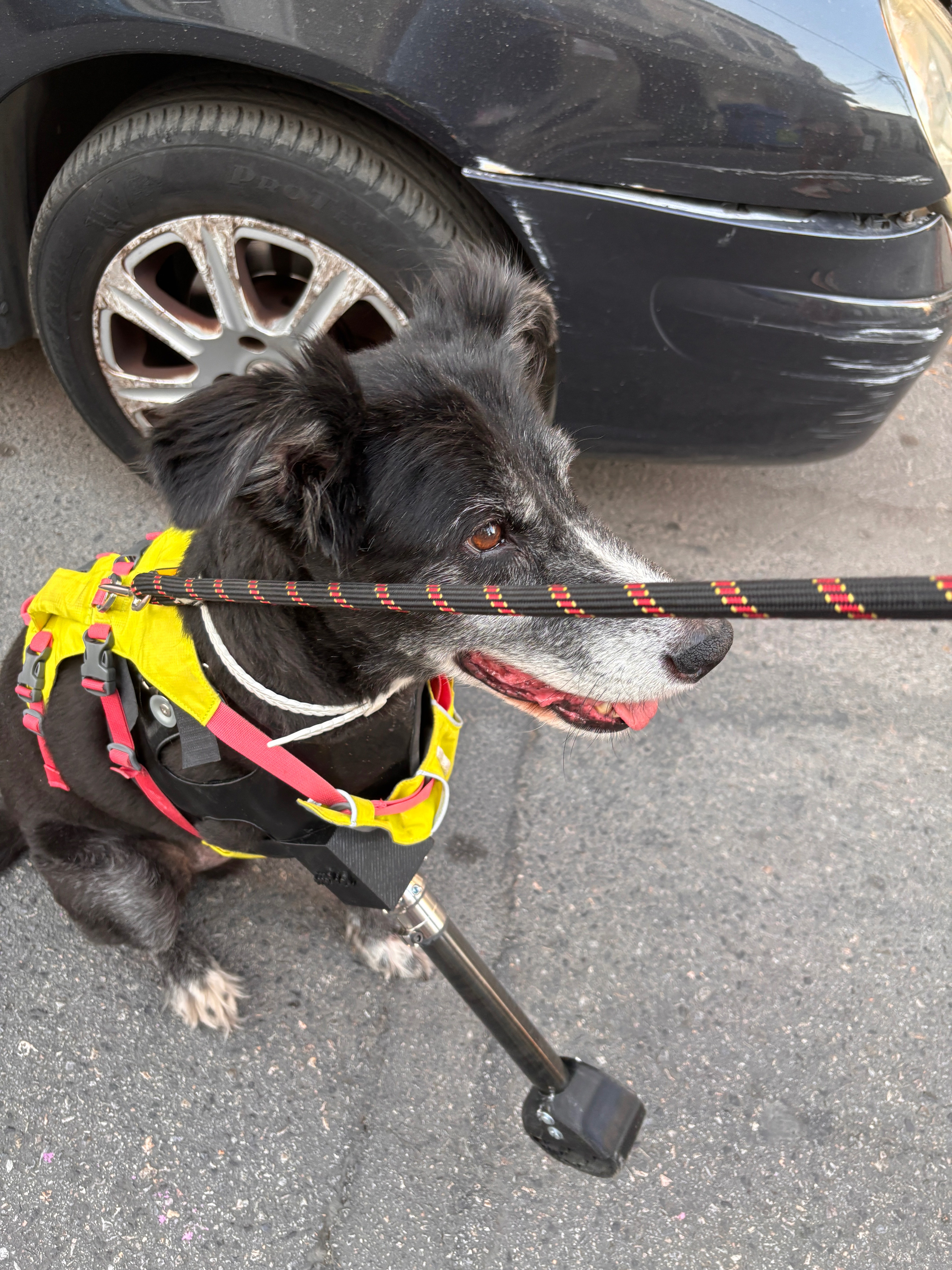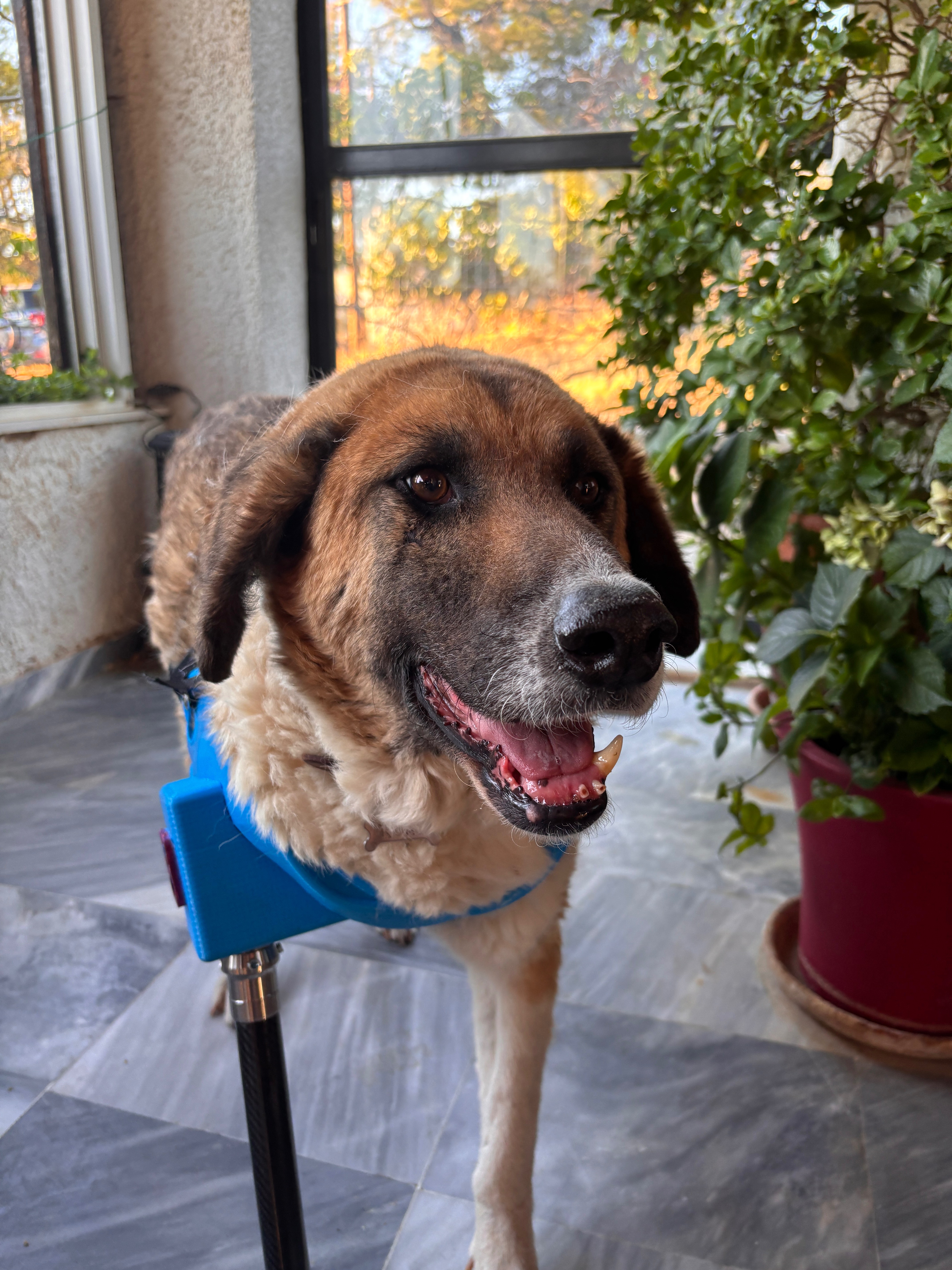Why Dogs Need Prosthetics
Understanding the medical problems that happen when dogs lose a leg and how prosthetics help solve them.
Many people think dogs "do fine" on three legs. While dogs are amazing at adapting, losing a leg creates serious health problems that get worse over time. These problems are hidden at first but can cause pain and disability later in life.
A prosthetic leg isn't just about helping dogs walk better. It's a medical device that prevents serious health problems, protects joints, and keeps dogs healthy and active as they age.

Confidence restored
The Problems & How We Fix Them
1. Too Much Weight on One Leg
The Problem
Dogs carry over 60% of their weight on their front legs. When one leg is missing, the other front leg has to carry almost double the weight. This extra weight wears out the joints much faster, causing arthritis and pain.[1, 2]
Our Solution
Our prosthetics share the weight between both front legs again. The prosthetic takes on much of the load, which protects the remaining leg from wearing out too quickly. This keeps joints healthy for much longer.
2. Bad Posture & Back Pain
The Problem
To stay balanced, three-legged dogs twist their body and lean to one side. This unnatural position puts constant stress on the spine, causing muscle strain, back pain, and disc problems.[3]
Our Solution
A properly fitted prosthetic lets dogs stand and walk naturally again. This fixes their posture, takes pressure off the spine, and prevents back problems. Our height-adjustable design ensures perfect alignment.
3. Weak Muscles & Poor Movement
The Problem
Three-legged dogs move in an awkward way that uses more energy. The muscles on the missing leg side get weak from not being used, while the other side gets overworked. This makes movement even harder.
Our Solution
Our prosthetics work like a real leg, helping dogs move normally again. The shock-absorbing design and flexible paw encourage natural walking patterns. This helps rebuild weak muscles and creates balanced strength.
Real Example: Pivot's Story
Before Getting a Prosthetic
Pivot lost his leg to cancer at age 2. By age 10, the problems started showing:
- X-rays showed severe arthritis in his remaining front leg joints
- Chest and shoulder muscles had gotten much weaker
- Could only walk for 10-15 minutes before getting tired
- Started limping on his good leg after any activity
- Had serious balance issues, especially on uneven surfaces
- His posture was twisted and hunched, which caused constant pain
- Avoided stairs and wouldn't jump on furniture anymore
- Even walking inside the house became difficult and painful
After Getting a Prosthetic
Just 4 weeks after getting his prosthetic:
- Walking became much more balanced and natural
- Could exercise much longer without getting tired
- Stopped limping after activities
- Balance problems completely disappeared
- His posture straightened out, eliminating the pain
- Gained confidence to use stairs and jump again
- Slept better and seemed much more comfortable
- Even when not wearing the prosthetic, he now walks normally inside the house
What This Shows:
Pivot's story shows what happens to most three-legged dogs over time. Even though he seemed fine for years, the damage was building up. The prosthetic not only helped when he wore it, but actually retrained his body to move properly. Now his muscles are stronger and his posture is corrected, so he moves better even without the prosthetic on.
The Difference Prosthetics Make

With the right prosthetic, dogs can return to their natural, confident movement patterns.
Research That Backs This Up
These aren't just our opinions. Scientific studies prove that three-legged dogs face these problems:
- Jarvis, C. L., et al. (2018). Compensatory load redistribution in naturally occurring canine tripods. *BMC Veterinary Research*, 14(1), 54. [Read Study]
- Kirpensteijn, J., et al. (2000). Kinetics of vertical ground reaction forces in dogs with unilateral thoracic limb amputation. *American Journal of Veterinary Research*, 61(4), 405-409. [Read Study]
- Wustefeld-Janssens, B. G., & Bockstahler, B. A. (2019). The effect of limb amputation on kinetic and kinematic variables in dogs. *Veterinary and Comparative Orthopaedics and Traumatology*, 32(01), 1-8. [Read Study]
- Ragetly, G. R., et al. (2010). Inverse dynamics analysis of the pelvic limbs in Labrador Retrievers with and without cranial cruciate ligament disease. *Veterinary Surgery*, 39(4), 513-522. [Read Study]
- Budsberg, S. C., et al. (1987). Force plate analysis of the walking gait in healthy dogs. *American Journal of Veterinary Research*, 48(6), 915-918. [Read Study]
- Gillette, R. L., & Angle, T. C. (2008). Recent developments in canine locomotor analysis: A review. *The Veterinary Journal*, 178(2), 165-176. [Read Study]